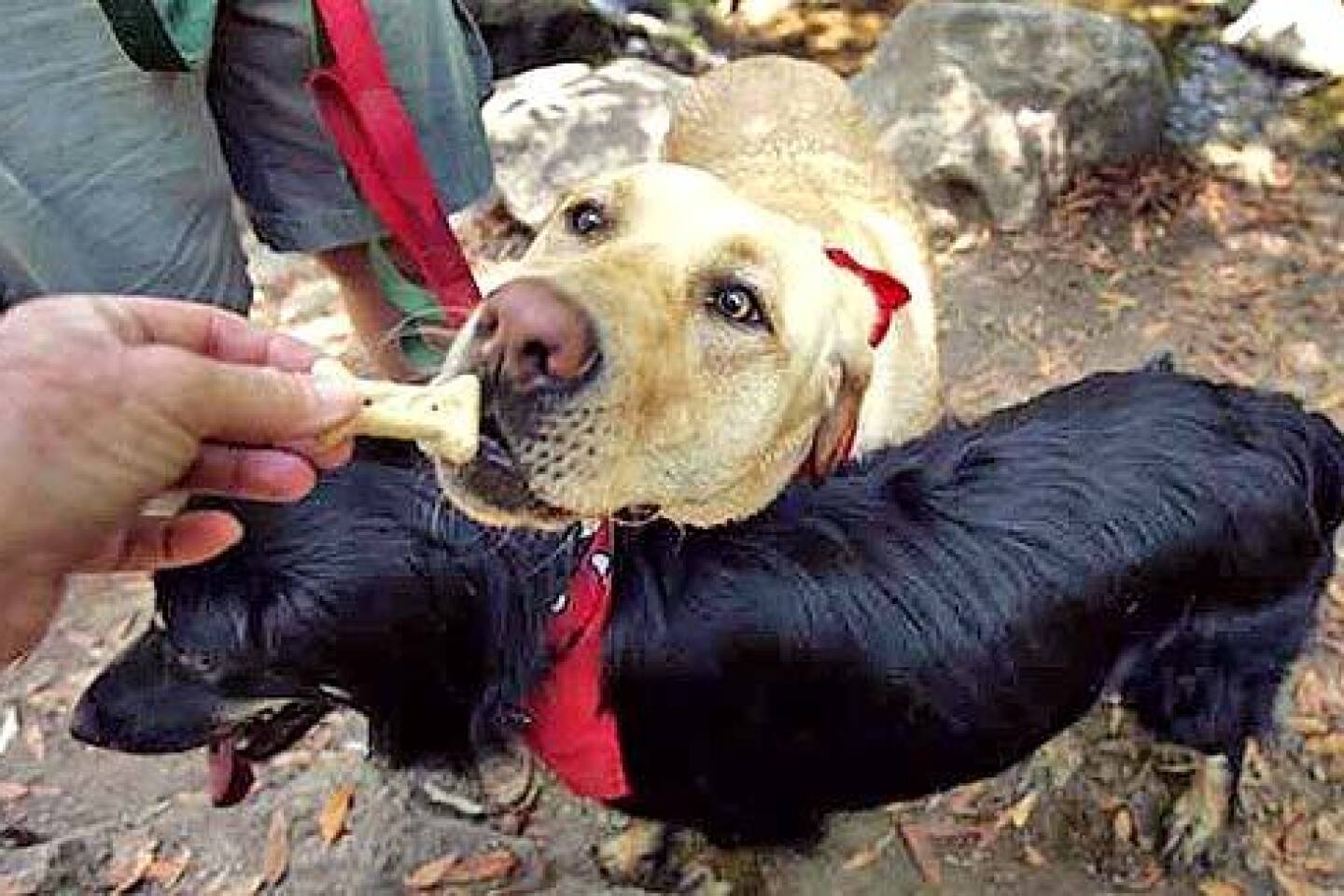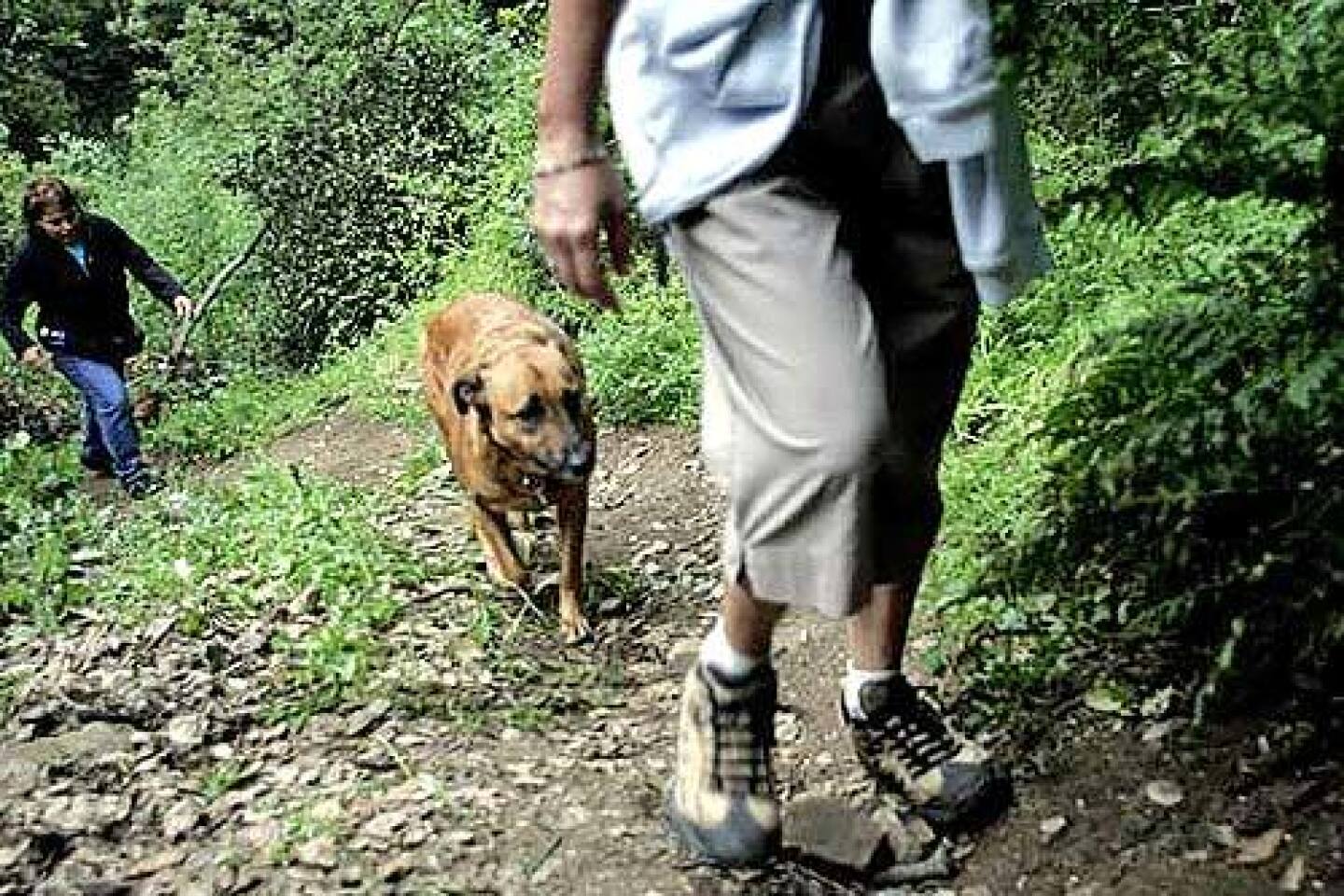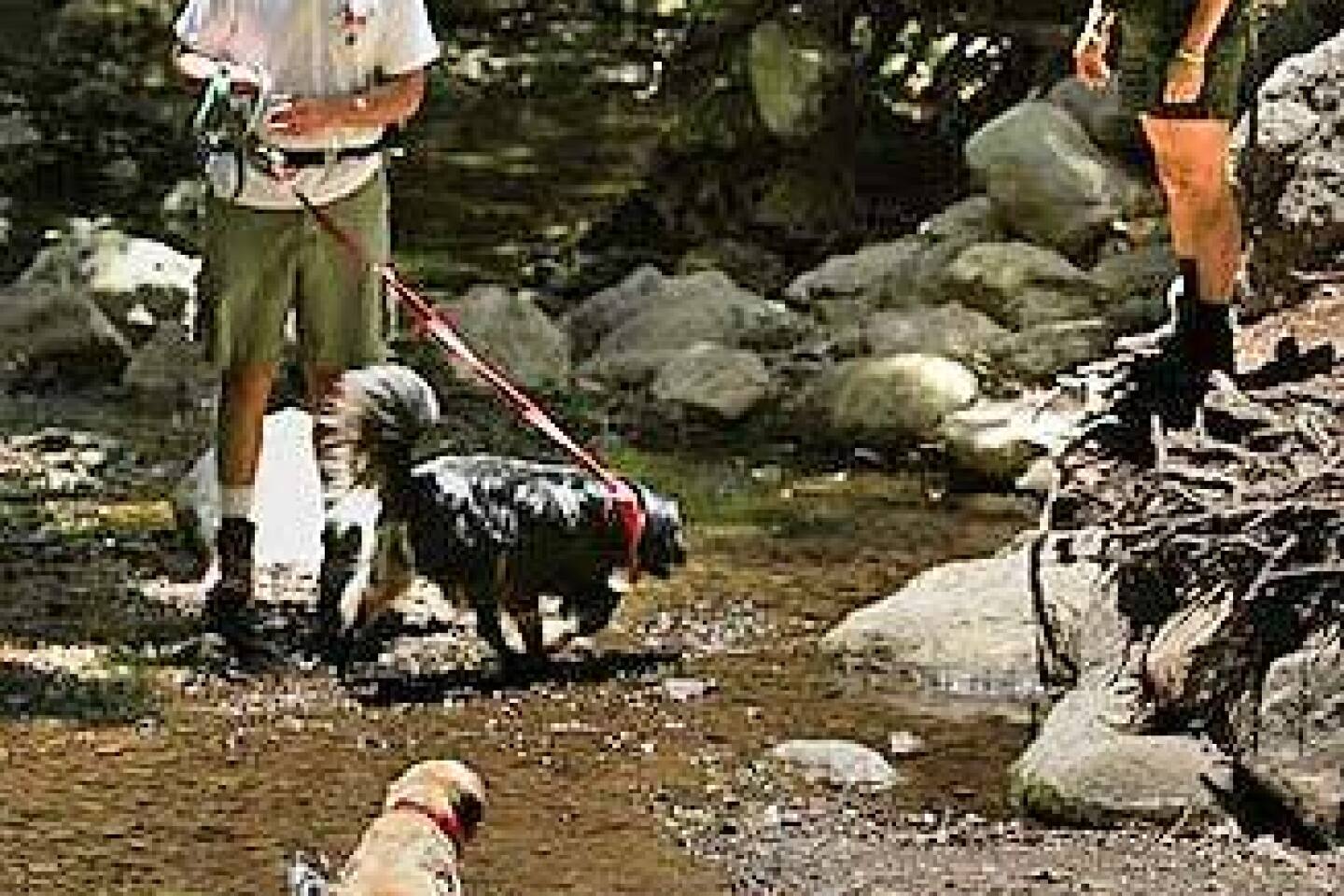Do Trail Leash Rules Go Too Far?
- Share via
A dog’s nose, of course, is where the trouble all begins.
Homer and Chase are running through Solstice Creek in the Santa Monica Mountains on a warm Sunday afternoon. They are splashing in shin-deep water, darting past salamanders and frogs and jumping over creek-side brush. Inside their long, whiskery snouts, the black Labrador and the Australian shepherd have at least 20 times more scent receptors than a blunt human nose, and the small slits along their nostrils allow them to draw extra air over those sensitive cells.
No wonder, then, the dogs in the creek are experiencing a sensory deluge: the aroma of eucalyptus, the scent of a tree-bound squirrel, a nearby jack rabbit. And then there are the sounds, all the sounds: splashing water, breaking twigs, chirping birds and so much more. A dog has a range of frequency three times that of a human.
Homer and Chase bound through the water, eyes wide, nostrils flared, ears perked. It doesn’t get much better than this.
But the fun ends when the soggy pooches dart from the creek and run headlong into Bonnie Clarfield, a National Park Service ranger known as the “dog narc” for her tenacious enforcement of the park’s leash laws.
“Where is your owner?” she asks from a nearby trail.
Seconds later, Austin Grady climbs out of the creek, a pair of leashes in his hands, a guilty expression on his face. Clarfield whips out her ticket book and fires off a $50 citation (as of July 1, the fine for violating the leash law in a national park is $75). In the Santa Monica Mountains National Recreation Area, all dogs must be on a leash.
“They were just playing in the water,” Grady protests, waving the leashes in the air. “It’s unfair to keep them on a leash.”
Dogs have accompanied their owners into the wilds for centuries. In 1880, John Muir explored the icy regions of southeastern Alaska in the company of a little black dog named Stickeen. At first, the Scotsman objected to the canine’s presence, but after the journey ended, he praised the animal’s tenacity and intelligence. That stumpy-legged mutt became Muir’s most cherished outdoor companion.
Today, Muir might be surprised at how completely dogs have insinuated themselves on trails and off, across beaches, forests and deserts.
On the shelves of most outdoor stores, dog owners can find a swath of dog hiking products, including portable water bowls, dog tents, leather hiking booties and backpacks designed for four-legged packers. In the past two years, sales of such items at REI alone have jumped 40%. Dog hiking clubs have sprouted across the country, from Maryland to Alaska.
Whether they’re wallowing in the creeks of the Santa Monica Mountains or scrambling up the White Mountain range in the Eastern Sierra, dogs have become another trail user competing for access, and owners, who take great pains to train trail-savvy dogs, assume their companions have no greater an impact than they do.
But the growing popularity of this pastime is changing the way we think about dogs and the outdoors.
Stickeen is long gone, and the areas where dogs are allowed to scamper are also disappearing, not entirely because of the behavior of the owners but because of what dogs naturally do.
Blame the nose, but an increasing number of park biologists claim that man’s best friend is not compatible with plants and animals in the wilds.
Leash law scofflaws
BACK at Solstice Creek, Clarfield tucks her ticket book into her backpack. She can’t begin to guess how many tickets she’s written for leash-law violations. Too many by her standards.“We expect people to do what they are supposed to when they get into a park,” she says.
For years, the primary rationale for leash laws was to restrain dogs from sniffing, pawing or mauling other park visitors, particularly young children. The leash issue still creates tension among hikers, and one highly publicized case that reverberated through the dog-hiking community is a reminder of how volatile conflicts over dogs can become.
It was late in the afternoon, May 2004. Grant Kuenzli was hiking in the Coconino National Forest in Arizona when his three unleashed dogs — a chow, a Labrador and a German shepherd mix — ran into retired teacher Harold Fish, who, because he says he feared for his safety, fired two warning shots with a pistol he carried. The dogs dispersed, but when Kuenzli allegedly confronted Fish, Fish fatally shot him. Prosecutors are pursuing second-degree murder charges against Fish, who claims self-defense.
The Kuenzli-Fish case isn’t a typical confrontation, but online forums for outdoor enthusiasts can’t put down the debate. “I will not allow someone’s uncontrolled canine to injure me, or mine,” a contributor to one forum said in a recent discussion about the case. “I will shoot ANY dog which behaves aggressively toward me.”
And then there are those who should know better: veteran hikers who become scofflaws because they can’t resist unleashing their dogs on the trails, defending their actions by suggesting that leash laws apply only to the owners of uncontrollable dogs.
On a Wednesday evening in Griffith Park, a group of about 20 or so hikers, including members of the K-9 Committee of the Angeles Chapter of the Sierra Club, meet to hike to Bee Rock, a peak overlooking the lights of nearby Glendale.
“Responsible dog owners keep dogs on a leash,” Karen Stewart says as she prepares to trek up a narrow dirt trail, her black poodle, Madison, at the end of a leash. “Unfortunately, one person ruins it for everyone.”
The hikers exchange greetings on a paved parking lot while the dogs sniff and eye each other. Among the hikers is Madeline Riepe, and her gold-colored mixed-breed, Heidi. As the group starts up the dirt trail, Riepe reaches down and unhooks Heidi’s leash — in violation of a Los Angeles city ordinance. None of the other hikers, including Stewart, complain. Heidi stays close to Riepe, never wandering more than a few feet away.
Not to worry, says Riepe. Heidi is well-trained, she says, and has always stayed by her side on the trail. Well, almost always, Riepe concedes. She recalls an incident a couple of years earlier when a hiker in Griffith Park shot pepper spray at Heidi after the unleashed dog rushed at the hiker.
“I was so mad,” she says. “I couldn’t believe he did that.”
Riepe shouldn’t be surprised. According to UC Davis veterinarian and animal behaviorist Lori Gaskin, a dog’s instincts to hunt and chase are so ingrained that those instincts often trump any amount of obedience training.
“I don’t routinely trust any dog when it’s in a new environment, regardless of training,” Gaskin says.
Banning dogs entirely
TODAY so many dog owners defy leash laws that park officials are taking the next logical step: banning dogs from specific areas of state and national parks.Rangers and biologists cite environmental studies that suggest canines, either leashed or unleashed, are a growing threat to habitat and wildlife.
They say the mere scent and sight of a dog can evoke panic among wild animals, much the way a dog’s not-so-distant relatives — wolves, coyotes and foxes — do. The studies are not new, but their warnings are increasingly relevant as more visitors frequent parks and as development encroaches parklands. Starting in the late 1960s and early 1970s, biologists produced numerous reports that warned about the impacts of dogs in the wild.
A 1999 study by Carolyn A. Sime, a wildlife biologist for Montana Fish, Wildlife & Parks, summarized the findings of many studies, saying: “Even if the chase instinct is not triggered, dog-presence in and of itself has been shown to disrupt many wildlife species.”
The Santa Monica Mountains National Recreation Area is a 154,000-acre wilderness that stretches from Point Mugu in Ventura County to the Hollywood Hills. Last year, the park had more than half a million visitors, a 21% increase over the previous year.
Nobody keeps track of the four-legged visitors, but the canine presence is so conspicuous in some areas that park officials proposed a 20-year trail management plan that prohibits pets on trails around Circle X Ranch and Zuma, Trancas, Cheeseburo and Palo Comado canyons.
Park officials believe the policy, if adopted, will preserve the remote, interior areas.
By keeping dogs off these trails, national park service planner Melanie Beck hopes to protect newts, deer and California quail, among other wildlife. “Animals are definitely harassed when you have dogs off leash,” she says.
State park officials in Northern California had similar motives when they recently banned dogs on all but one trail in the Lake Earl and Mad River wilderness areas near the Oregon border. Rangers there spotted unleashed dogs repeatedly chasing ducks, Canada Aleutian geese and other birds.
In the Santa Rosa and San Jacinto Mountains National Monument south of Palm Desert, federal authorities recently imposed a temporary dog ban on 42 miles of public trails where untethered dogs have been seen chasing the endangered bighorn sheep that inhabit this 272,000-acre wilderness.
Biologists say the stress caused by the dogs — whether they chase the sheep or merely pass through the breeding habitat — can reduce the sheep’s fertility rates. Authorities are now considering making the temporary ban permanent.
“It’s logical for sheep to see dogs as predators, whether they are on a leash or not,” says Jim Foote, a planner for the Bureau of Land Management.
Wynne Benti offers a slightly different perspective. Benti co-founded the K-9 Committee of the Angeles Chapter of the Sierra Club and wrote a guide book on dog hiking around Los Angeles. She promotes responsible dog hiking and wonders if dogs are being unfairly targeted.
“I have a greater fear of the damage caused by all-terrain vehicles,” she says. “If they start to limit those places where I can take my dog, it would be sad.”
Urban dogs run amok
AS Clarfield bounds up a narrow dirt path, she fires off the names of blooming wildflowers, describes reconstruction projects at the park and recounts the animals she has encountered.The dog narc has been a ranger for 24 years. She loves dogs, has two puppies herself, and she does not object to park visitors bringing their dogs into the backcountry. But she is frustrated that so much of her time on the trails is spent citing hikers who let their dogs roam free on the trails.
“People don’t understand,” Clarfield says. “Dogs are a threat to wildlife.”
Her pace slows as she recalls that day nine years ago when her perspective on dogs in the park changed and she began enforcing the leash law so passionately that she earned her nickname.
She was on patrol on a Sunday afternoon when she came across a hiker walking out of Zuma Canyon, carrying a dying German shepherd.
The dog had roamed off leash and had been bitten in the mouth by a rattlesnake. Clarfield tried frantically to call a veterinarian to treat the animal but she couldn’t find a clinic or veterinarian’s office that was open. The dog died in front of her.
“Most of these dogs are urban dogs,” she says. “They are not used to what they encounter on the trail.”
Clarfield heads toward the end of the Rising Sun Trail where dog owners make a habit of unleashing their pets near a shady waterfall. She adjusts her backpack and quickens her pace.
*
Hugo Martín can be reached at hugo.martin@latimes.com.*
(BEGIN TEXT OF INFOBOX)
TIPS
Working out with Rosy
Dogs, just like humans, require conditioning before tackling the trails. Altitude, temperature and weather conditions affect them too. One expert shares a routine she follows for taking her dog to the Sierra.
It’s several weeks before Wynne Benti plans to take her dog, Rosy, to the top of White Mountain Peak, a 14,246-foot summit in the Eastern Sierra and the third tallest peak in California.
But Benti, the author of “Favorite Dog Hikes in and Around Los Angeles,” knows that her 2-year-old Australian cattle dog will need as much training as she does to make the summit.
Here’s how she prepares:
Make sure Rosy is in shape by taking her hiking on several smaller mountains, such as 5,558-foot Josephine Peak in the nearby San Gabriel Mountains. Keep an eye on her paws for cuts, blisters and thorns.
Pack three liters of water for the day hike — two for Rosy and one for herself — and a plastic water bowl in which the dog’s water is mixed with Gatorade to replace carbohydrates and electrolytes. For backup, haul five gallons of water in the car.
Carry a day’s supply of dog food and dog biscuits and bring plastic bags to carry out Rosy’s waste.
Bring a leash and collar to tether Rosy when other hikers or dogs come into view, even though she’s allowed off-leash along the 7 1/2 -mile route in the Inyo National Forest. The dirt road, mostly free of rocks, means she won’t need to bring Rosy’s leather booties.
Offer Rosy water and biscuits every mile or so during the hike. At the peak, take a break. Eat lunch. Show Rosy the panoramic view of the Sierra Nevada. “For dogs, it’s all about the experience of being out there,” says Benti.
In Benti’s book she offers more tips on hiking with dogs:
Create a “hands-free” leash using a carabiner, the U-shaped clip used by climbers, to affix the leash to your waist or pack.
Be aware that dogs can suffer from heat exhaustion (vomiting, stumbling gait, overall exhaustion) and hypothermia (uncontrollable shivering, weakness, difficulty moving) just like humans.
Be prepared to carry your dog out if it gets injured or becomes too tired to walk.
Check trail access before you go. Each agency — city, county, state or federal — has its own set of rules concerning dogs.
— Hugo Martín
More to Read
Sign up for Essential California
The most important California stories and recommendations in your inbox every morning.
You may occasionally receive promotional content from the Los Angeles Times.



















